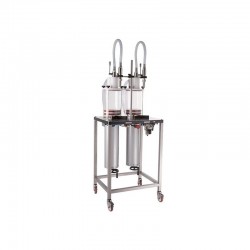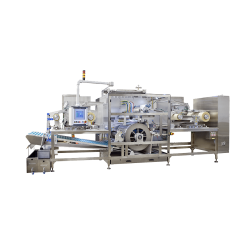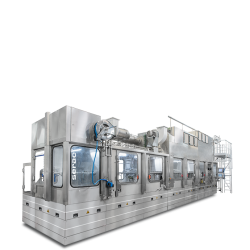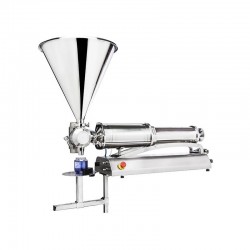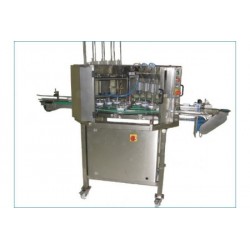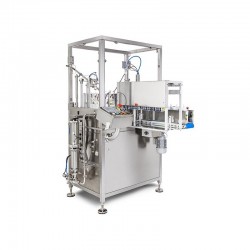
- Nuovo
BMS 1.6
The HFFS machine BMS 1.6 can work in simplex and duplex, forming and filling pouches within a range of 70 x 80 mm. and 160 x 300 mm.
Descrizione
The HFFS machine BMS 1.6 can work in simplex and duplex, forming and filling pouches within a range of 70 x 80 mm. and 160 x 300 mm. It can reach an output of 120 pouches per minute and can fill up to 1,200 cc of product.
BMS State-of-the-art technology
The BMS features a transmission system, a Bossar patented invention, which enables for multiple independent axis movements.
This technology substitutes the traditional and standard single cam shaft, and therefore has significantly fewer mechanical parts. The control is provided by means of an intuitive touch screen HMI, facilitating format change-over and adaptability to multiple formats. This is made possible by the servo technology, which enables independent movements of machine parts.
The BMS produces pouches with excellent seals, equal to the quality of premade pouches. Moreover, these machines produce pouches with a huge number of designs and shapes for a better product differentiation on the shelf.
BMS Features. Servo Technology, Full control of machine operation
Pouch width automatic correction system, allows for a productivity up to 10% higher than mechanical HFFS machines
Accessibility for easier maintenance facilitated by the 3D touch screen. Which includes instructions manuals, electronic and pneumatic diagrams.
Little maintenance is required because the BMS machines possess fewer mechanical parts. And its Sanitary construction simplifies the machine.
The BMS machines are also more eco-sustainable from an energetic consumption point of view. In fact, the servo engines accumulate the excess power and send it back to the grid, effectively increasing energetic efficiency and reducing consumption.
Option of Fitments, zippers and straws.
BMS Technology
Full servo motion
This smart servo-control system allows independent operation between the different stations, offers great reliability and little maintenance.
Walking beam
Traditional walking beam transport system consisting of beams and grippers. They hold the pouches and transport them through the different stations, from the pouch forming to the pouch closing.
Mirror machine
Placing one standard machine in front of the other operating the opposite direction makes operating easier and reduces staff required to control them.
Filling options.
Each product requires a specific filling technology. Aseptic, ultraclean, ambient and hot-fill; we have it all.
Hot Fill. High-acid products
Hot-fill processing fills heated, commercially sterile product in non-sterile packaging.The product is held for a predetermined time and temperature to sterilize the packaging prior to the filling process. The longer hold time at high temperatures reduces quality of the product. Only high-acid products can be hot-filled and held at ambient temperatures without refrigeration.
Clean Fill. Cold-chain Solution
The ambient fill method uses cold to kill bacteria. The food also remains cool until it is time to fill the containers. Cold filling is popular because it does not require the use preservatives or other food additives to protect food. Cold filling is used for packing food products that have dairy as a main ingredient. Therefore, any food that has milk or cream as its base is suitable for the cold filling process.
Ultra Clean. Cold-chain Solution, high sterility
Ultra clean levels are achieved in packaging by means of laminar flow, U.V. lamps and/or hydrogen peroxide. Essentially to achieve high sterility levels for short shelf-life products. These applications are required to fill fruit juice, compote, yogurt and dairy products intended for the Cold-chain distribution.
Aseptic. Shelf-stable solution
Aseptic processing and packaging is the filling of commercially-sterilized products into pre-sterilized containers. Commercially sterile, cooled product is processed separately from the packaging. Incoming packaging is sterilized independently from the product. Packaging is filled and hermetically sealed with a pre-sterilized closure in an atmosphere free of microorganisms (refer to diagram below).
Sealing options.
We have pioneered a revolutionary sealing technology which will empower our customers to choose for sustainable and recyclable packaging solutions. Regardless of this, we are glad to offer the more traditional sealing methods, such as Ultrasonic and Heat sealing.
Heat Seal. The Classical Way
- Based on electric resistance.
- Reliable and low cost.
- Easy engineering.
- Cooling step is needed.
- Multiple steps are needed to guarantee sealing quality, increasing the total machine footprint.
Ultrasonic Seal. Cold Sealing
- Using high frequency vibrations, it seals the packaging due to molecular vibration within the film.
- Hermetic seals regardless of seal area contamination.
- Significant reduction in packaging material consumption due to:
- Smaller sealing area.
- Reduced head space in the pouch.
- High reproducibility process.
- Quicker sealing times.
- Mechanical cutting and sealing in the same step.
Induction Seal. The Revolutionary Sealing Method
- Novel sealing system based on heat-generation by electro-magnetic field.
- Heat and Cooling in one single step:
- Less stress to the film.
- Sealing jaws remain closed until film is cold.
- Continuous motion sealing process.
- Adjustable to any film structure.
- Sealing time reduced by 1/3 of the time compared with Heat sealing.
- Designed for Circular Economy packaging.
64 altri prodotti della stessa categoria:
- Nuovo
- Nuovo
- Nuovo
- Nuovo
- Nuovo
- Nuovo
- Nuovo
- Nuovo
- Nuovo
TPM 1000 fully automatic thermoforming packaging machine
- Nuovo
- Nuovo

 English
English
 Deutsch
Deutsch
 Français
Français
 Español
Español
 Italiano
Italiano
 Português PT
Português PT









